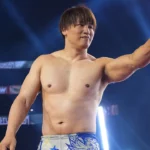Get ready to dive into the fascinating world of Steve Blackman, the guy who rocked the WWE as “The Lethal Weapon.” From the streets to the ring, Blackman’s journey is packed with thrilling moments and jaw-dropping moves. Join us as we explore his epic background, martial arts skills, and the unforgettable impact he left on wrestling. This is the inside scoop on a true legend, so sit back, relax, and let’s get to know the one and only Steve Blackman.
Facts about Steve Blackman
Let’s talk about Steve Blackman, a name that might ring a bell for wrestling fans. He wasn’t just another wrestler; this guy brought something special to the ring. What made him so intriguing? Well, picture this: a martial arts expert stepping into the world of professional wrestling. That’s Blackman in a nutshell.
Blackman’s dedication to martial arts extended far beyond his time in the ring. He immersed himself in various disciplines, including Kenpo, Jeet Kune Do, Muay Thai, and Karate, incorporating these styles into his wrestling to create a unique and captivating fighting style.
Remember those iconic nunchucks? They weren’t just for show. They became a symbol of his “Lethal Weapon” persona – a perfect fit for a guy who moved with such speed and precision. His agility was remarkable, dodging, weaving, and striking with an almost superhuman ability that left his opponents disoriented and the crowd in awe.
Speaking of awe, let’s not forget his time as Hardcore Champion in the WWF. Blackman wasn’t just messing around in this division; he dominated it. He snagged that Hardcore Championship title a whopping six times! To put that into perspective, holding that title six times means he was a force to be reckoned with in a division known for its brutality. He wasn’t just surviving in the hardcore world; he was thriving.
What Martial Arts Does Steve Blackman Know?
Blackman wasn’t just a tough guy in the ring; he was a walking arsenal of martial arts skills. His bread and butter? That would be Shotokan karate, where he reached the level of mastery. But he didn’t stop there. He wanted every tool in the toolbox, so he became proficient in boxing and explored other fighting styles like wrestling, kickboxing, judo, jiu-jitsu, Muay Thai, and even Eskrima, the Filipino stick fighting art. This guy was ready for anything!
Imagine stepping into the ring with someone who could switch from powerful karate strikes to lightning-fast boxing combinations, all while having the grappling skills to take you down. That was the challenge Blackman presented.
Here’s the rundown of what made Blackman’s fighting style so effective:
- Mastery of Shotokan Karate: This traditional style emphasized powerful strikes and linear techniques, giving Blackman a strong base for his offense.
- Boxing Prowess: By blending in boxing techniques, he added versatility and speed to his strikes, making him unpredictable.
- A Fusion of Styles: It wasn’t just about knowing different martial arts; it was about seamlessly integrating them. Blackman could transition from a Muay Thai clinch to a judo throw without missing a beat.
The result? An incredibly well-rounded fighter who could adapt to any opponent or situation. Blackman’s fighting style was a testament to his dedication and a key factor in his success in the world of professional wrestling.
How Much Does Steve Blackman Weigh?
Now, we all know Steve Blackman as this absolute unit in the ring, right? The “Lethal Weapon” wasn’t just a nickname, the guy was seriously ripped. It makes you wonder, just how much did this guy weigh? Well, during his prime, Blackman usually came in at around 218 pounds of pure muscle. That’s 99 kilograms for those who prefer the metric system – either way, it’s a lot of weight behind those kicks and punches!
You don’t get a physique like that by accident. We’re talking hours upon hours of intense training, honing his body into a weapon. Remember, Blackman wasn’t just a wrestler, he was a martial artist at his core. That meant needing both explosive power and the strength to grapple with the best of them.
But it wasn’t just about functionality, was it? Blackman’s weight played a huge part in his overall presence. He walked into the ring, and you instantly knew this guy meant business. The sheer size of him, combined with that intense stare, was enough to make anyone think twice about stepping up to him.
When Did Steve Blackman Leave the WWE?
Blackman’s career took a turn in 2002 when he had to hang up his wrestling boots due to nagging neck injuries. It was a tough break for fans who loved his hardcore style and martial arts skills.
Blackman wasn’t afraid to push the limits and throw down in the ring, earning him the nickname “Lethal Weapon.” He wasn’t all brute force, though. Blackman was a skilled grappler and striker, making him a real threat to anyone he faced.
Remember his time in the Hardcore division? This guy was a beast, racking up six Hardcore Championship wins. He wasn’t afraid to get a little rough around the edges, and the fans ate it up. He was a true fan favorite during the wild days of the Attitude Era.
Following his departure from the WWE, Blackman explored the world of MMA. He opened a gym and even trained fighters, showcasing his versatility and passion for combat sports. In a surprising career change, he also became a bail bondsman – talk about a diverse skill set!
Even though he’s no longer with the WWE, Blackman is still a respected figure in the wrestling community. He helped pave the way for incorporating martial arts into wrestling, and his influence can still be seen today. He might have left the ring, but his legacy in the world of professional wrestling is secure.
When Did Steve Blackman Debut?
Blackman brought his hard-hitting, martial arts-infused style to the WWE ring in 1997, but pinpointing the exact date of his debut is a bit tricky. The world of professional wrestling encompasses house shows, dark matches, and televised events, all contributing to a wrestler’s journey. Some sources might point to his first televised appearance as his official debut, while others might consider his earlier, untelevised matches as the true starting point.
What we do know for sure is that by 1997, “The Lethal Weapon” had arrived, and he wasted no time leaving his mark. His blend of martial arts expertise and no-nonsense attitude quickly earned him a dedicated following. He wasn’t flashy, he didn’t rely on gimmicks – Blackman was all business, and fans respected that.
Imagine a skilled martial artist, trained in multiple disciplines, suddenly stepping into a world of larger-than-life personalities and theatrical showmanship. That was Steve Blackman. He was a stark contrast, and that’s precisely what made him stand out.
Who Is the Famous Martial Art Guy?
While there are many famous martial artists, Steve Blackman’s name stands out for his unique transition from the disciplined world of martial arts to the theatrical realm of professional wrestling.
Blackman’s journey began with Stampede Wrestling, where he learned to grapple and strike with the best of them. He honed his skills in different wrestling circuits, building a reputation as a force to be reckoned with before entering the WWE in 1997.
His nickname, “The Lethal Weapon,” was a testament to his fighting prowess. Blackman seamlessly blended his martial arts mastery into his matches, transitioning from lightning-fast karate strikes to brutal submission holds with ease.
His dominance in Hardcore matches, racking up six Hardcore Championship wins, proved that he could brawl with the toughest in the WWE and emerge victorious. His background in Karate, Taekwondo, and Brazilian jiu-jitsu allowed him to adapt to any opponent or fighting style, making him a formidable presence in the ring.
Sadly, nagging neck injuries forced Blackman to retire in 2002. However, he didn’t let retirement slow him down. He explored the world of MMA, did some training, and even worked as a bail bondsman, showcasing his adaptability and diverse skillset.
Even though he’s retired from the ring, Steve Blackman’s legacy as “The Lethal Weapon” lives on. He’s remembered as one of the most skilled and toughest competitors to ever step foot in a WWE ring.
Who Is the Black Actor in Martial Arts?
When it comes to black actors in martial arts films, many notable names come to mind, but it’s important to distinguish between actors who portray martial artists on screen and those with legitimate fighting backgrounds.
While Steve Blackman’s career primarily revolved around professional wrestling, his authentic martial arts skills set him apart. He wasn’t just playing a role; he was a true martial artist who brought a new level of realism to the ring.
Blackman’s nickname “Lethal Weapon” wasn’t just for show. He held black belts in Taekwondo and Shotokan karate and had trained extensively in other disciplines, including Escrima and Aikido. This real-world experience is evident in his wrestling style, which blended fluidity and precision with raw power.
While Blackman might not have always been in the main event picture, his influence on professional wrestling is undeniable. He helped pave the way for other martial artists looking to enter the world of professional wrestling, proving that legitimate fighting skills could be seamlessly integrated with the theatricality of the industry.
Did Honor Blackman Know Martial Arts?
While Honor Blackman, best known for her role as Pussy Galore in the James Bond film “Goldfinger,” wasn’t a martial artist in the same vein as Steve Blackman, she did undergo judo training with expert Jayne Collins for her role.
This training was crucial for the film’s fight scenes, where she needed to convincingly take down opponents twice her size. Although not a martial arts master, Honor Blackman embraced the physical demands of her role, displaying athleticism and a commitment to realism.
What Martial Art Does Black Panther Know?
Black Panther, the formidable warrior and king of Wakanda, isn’t just strong and fast; he’s a master of multiple martial arts, seamlessly blending them to overpower his adversaries.
While the movies don’t explicitly detail every move, his fighting style suggests influences from various disciplines:
- Brazilian Jiu-Jitsu (BJJ): Black Panther utilizes throws, takedowns, and holds reminiscent of BJJ, showcasing his ground fighting skills and ability to control opponents without relying solely on strength.
- Muay Thai: His devastating kicks and elbow strikes point to Muay Thai, known for its powerful strikes using shins, knees, and elbows.
- Taekwondo: Black Panther’s lightning-fast kicks and spinning attacks suggest Taekwondo, a Korean martial art emphasizing speed and agility.
However, Black Panther’s fighting style isn’t confined to any single discipline. He seamlessly blends these different arts, adapting his approach based on his opponent and the situation. Some even speculate that he incorporates lesser-known African fighting styles, which could be fascinating to explore in future films.
Let’s not forget, Black Panther trained in Wakanda, a technologically advanced nation with its own unique approach to combat. It’s safe to say he has a few tricks up his sleeve that we haven’t even seen yet.
Here’s a quick breakdown:
| Martial Art | Description | How Black Panther Uses It |
|---|---|---|
| Brazilian Jiu-Jitsu | Ground fighting and submissions | Throws, takedowns, joint locks, controlling opponents |
| Muay Thai | Powerful strikes with elbows, knees, shins | Devastating kicks, knee strikes, elbow attacks |
| Taekwondo | Speed, agility, kicking techniques | Fast kicks, spinning attacks, acrobatic maneuvers |
What Martial Arts Did Billy Blanks Study?
Billy Blanks, the fitness icon behind Tae Bo, is a martial arts legend with an impressive background. He holds black belts in not one, not two, but seven different disciplines: Taekwondo, Karate, Boxing, Kickboxing, Judo, Jiu-Jitsu, and Muay Thai.
Blanks didn’t just dabble in these arts; he excelled. He’s a seven-time world karate champion and captained the United States karate team to victory, demonstrating exceptional talent and leadership. His trophy cabinet boasts a collection of 36 international gold medals, earning him a well-deserved spot in the prestigious Karate Hall of Fame.
Blanks’ passion for martial arts goes beyond winning competitions. He believes in their transformative power and has dedicated his life to sharing that passion through teaching, books, workout videos, and even acting roles in action movies.
What makes Blanks’ story even more remarkable is that he achieved all of this after overcoming a significant challenge in his childhood. Born with a hip joint anomaly, he faced physical limitations, but instead of giving up, he found strength and empowerment through martial arts.
What Martial Arts Is Captain America Trained In?
Captain America, the shield-wielding super soldier, might not be a mystical martial arts master, but he’s an incredibly skilled and adaptable fighter. He combines his enhanced strength and agility with practical fighting techniques, creating a unique style that draws inspiration from various disciplines:
- Boxing: Boxing forms the foundation of Captain America’s fighting style. With his super-strength, even a simple jab can send opponents flying.
- Taekwondo: Those incredible flying kicks? That’s likely Taekwondo shining through. This Korean martial art is known for its powerful kicks and dynamic spinning techniques.
- Judo: When he needs to take the fight to the ground, Captain America utilizes Judo, a Japanese martial art focusing on grappling, throws, and joint locks.
- Muay Thai: In close-quarters combat, Captain America employs Muay Thai, known for devastating elbows, knees, and clinching techniques.
However, Captain America’s fighting skills extend beyond traditional martial arts:
- Military Combatives: His rigorous military training makes him a master of hand-to-hand combat, weapon disarming, and tactical thinking.
- Professional Wrestling: Some of Cap’s throws and grappling maneuvers wouldn’t look out of place in a wrestling ring. While not a traditional martial art, professional wrestling likely influenced his ability to use an opponent’s weight against them.
- Discus Throw: That iconic shield throw? It’s a testament to his discus-throwing days, which honed his accuracy and ability to use his shield offensively and defensively.
Captain America’s true strength lies in his adaptability. He analyzes his opponents, identifies their weaknesses, and adapts his fighting style accordingly. This makes him a formidable opponent, whether he’s facing super soldiers or aliens.
- Unlocking Francis Alexander Shields’ Finance Empire: A Comprehensive Biography - July 12, 2025
- Unveiling Francis Alexander Shields: A Business Legacy - July 12, 2025
- Francis Alexander Shields’ Business Career: A Comprehensive Overview - July 12, 2025















